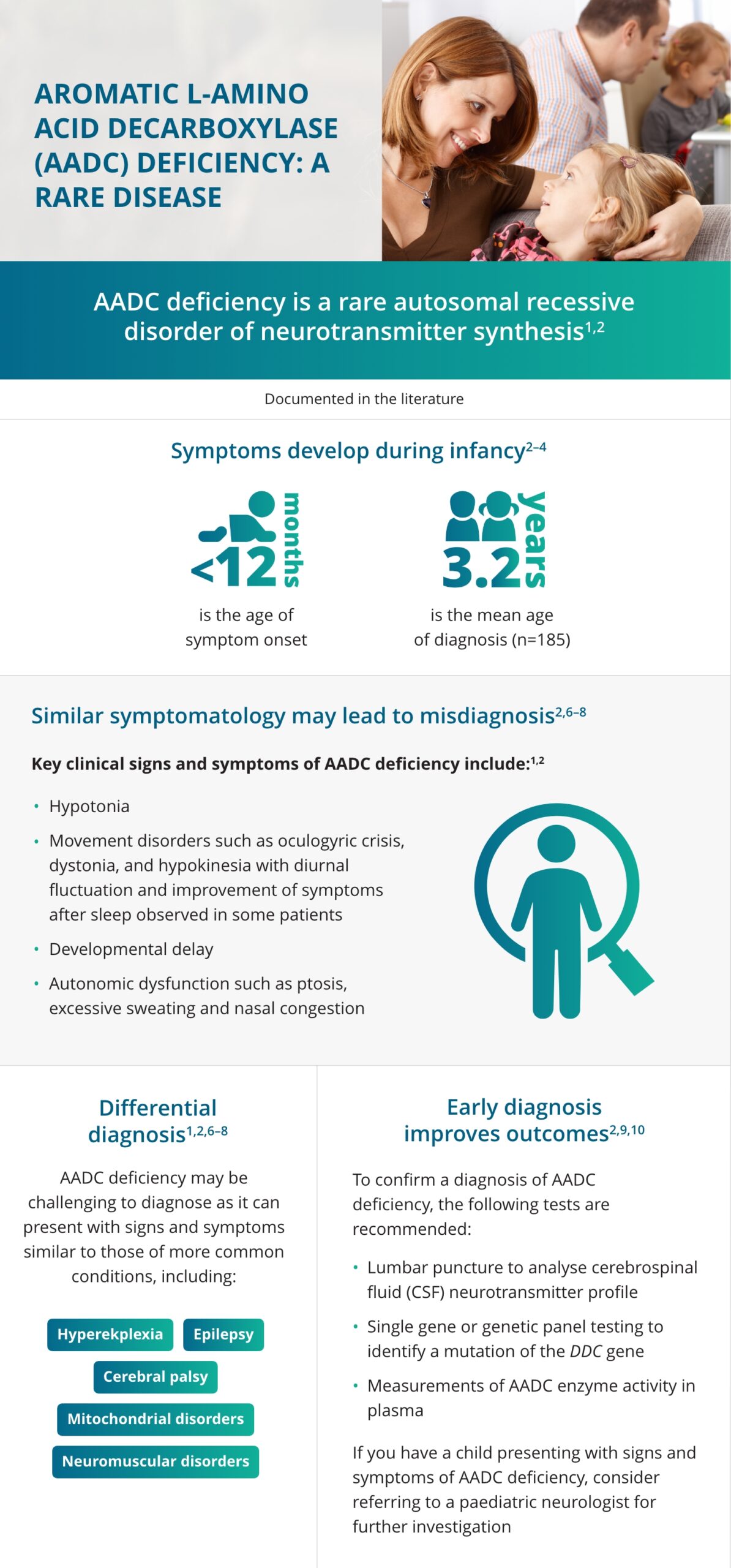Summary of AADC deficiency
Aromatic L-amino acid decarboxylase (AADC) deficiency is a rare, genetic disease.1,2 A mutation in the DDC gene results in reduced activity of the AADC enzyme.1,2 The AADC enzyme plays an important role in producing the key neurotransmitters, dopamine and serotonin.2
In AADC deficiency, the reduction of these neurotransmitters causes the associated symptoms, such as hypotonia, movement disorders, developmental delay and autonomic symptoms.2 Symptoms may appear around 3 months of age, but mean diagnosis can be delayed until 3.5 years of age.2
Animation: Signs and symptoms of AADC deficiency
Watch this short animation to learn more about the biochemical basis of AADC deficiency, the commonly observed symptoms and the guideline-recommended tests for definitive diagnosis.
Signs and symptoms of AADC deficiency2
 Hypotonia
Hypotonia
Children with AADC deficiency commonly have hypotonia with poor head control
 Developmental delay
Developmental delay
Children often have delayed motor, cognitive and speech development
 Movement disorders
Movement disorders
The most common movement disorder in AADC deficiency is oculogyric crises, but dyskinesia, dystonia, hypokinesia, tremors and myoclonus can be present
 Oculogyric crises3
Oculogyric crises3
An involuntary upward deviation of the eyes that are often mistaken for seizures
 Autonomic dysfunction
Autonomic dysfunction
Multiple symptoms associated with the autonomic nervous system such as nasal congestion, excessive drooling, temperature instability
Infographic: Signs and symptoms of AADC deficiency
Despite early symptoms appearing by 2.7 months of age, diagnosis is delayed with a mean diagnostic age of 3.5 years.2 This is often because symptoms of AADC deficiency overlap with other more common conditions such as epilepsy or cerebral palsy, leading to potential misdiagnosis.4 Identifying AADC deficiency symptoms and carrying out appropriate diagnostic tests can help to ensure early diagnosis and improve outcomes for patients and their caregivers.2–5

If patients present with neurological symptoms of unknown aetiology in childhood, further testing and referral to paediatric neurologists are warranted.
Learn more about differential diagnoses
REGISTER NOW: Access exclusive expert-led educational content
- Brun L, et al. Neurology. 2010;75:64–71.
- Wassenberg T, et al. Orphanet J Rare Dis. 2017;12:12.
- Rizzi S, et al. Behav Neurol. 2022;2022:2210555.
- Bergkvist M, et al. Future Neurol. 2022;17(4):FNL63.
- Lee WT. Epilepsy & Seizure. 2010;3(1):147–153.
- Ng J, et al. Nat Rev Neurol. 2015;11(10):567–584.
- Krigger KW. Am Fam Physician. 2006;73(1):91–100.
- Pons R, et al. Neurology. 2004;62:1058–1065.
- Himmelreich N, et al. Mol Genet Metab. 2019;127(1):12–22.
- National Organization for Rare Diseases. AADC deficiency. Available from: https://rarediseases.org/rare-diseases/aromatic-l-amino-acid-decarboxylase-deficiency. Accessed March 2024.